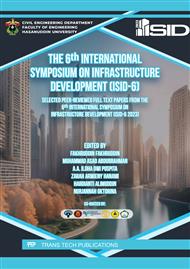[1]
R. A. Van Zuidam, Guide to geomorphologic-aerial photographic interpretation and mapping. Enschede, Netherlands (1983)
Google Scholar
[2]
Z. T. Bieniawski, Engineering rock mass classifications: a complete manual for engineers and geologists in mining, civil, and petroleum engineering. Wiley, New York (1989)
Google Scholar
[3]
A. Palmström, Combining the RMR, Q, and RMi classification systems. Tun. Undgr. S. Tech. 24 (2009) 491–492
DOI: 10.1016/j.tust.2008.12.002
Google Scholar
[4]
A. C. Engineers, Final report: preparation of Rongkong multipurpose dam. Jakarta, Indonesia (2022)
Google Scholar
[5]
D. Castro-Fresno, J. Álvarez-García, F. Ballester-Muñoz and R. Diego-Carrera, Correlation between Bieniawski's RMR and Barton's Q index in low-quality soils. Rev. de la Cons. (2010) 107–119
DOI: 10.4067/s0718-915x2010000100012
Google Scholar
[6]
L. Ali, I. G. B. Indrawan and Hendarto, Weak rock mass characterization for determination of support system of the DK99-DK100 Jakarta – Bandung speed railway tunnel, Indonesia. IOP Conf. Ser.: Earth Environ. Sci. 871 (2021)
DOI: 10.1088/1755-1315/871/1/012060
Google Scholar
[7]
Japan Society of Civil Engineers, Standard specifications for tunneling-2006: mountain tunnels. Tun. Eng. Committee (2007)
Google Scholar
[8]
H. Rehman, W. Ali, A. M. Naji, J. J. Kim, R. A. Abdullah and H. K. Yoo, Review of rock-mass rating and tunneling quality index systems for tunnel design: development, refinement, application, and limitation. Appl. Sci. 8 (2018)
DOI: 10.3390/app8081250
Google Scholar
[9]
D. J. W. Mboussa and S. Sun, Analysis of rock mass behavior with empirical and numerical method for the construction of diversion tunnel, Laos. IOP Conf. Ser.: Mater. Sci. Eng. 1212 (2020)
DOI: 10.1088/1757-899x/1212/1/012028
Google Scholar
[10]
H. Basarir, A. Ozsan and M. Karakus, Analysis of support requirements for a shallow diversion tunnel at Guledar dam site, Turkey. Eng. Geol. 81 (2005) 131–145
DOI: 10.1016/j.enggeo.2005.07.010
Google Scholar
[11]
Z. Gurocak, P. Solanki and M. M. Zaman, Empirical and numerical analyses of support requirements for a diversion tunnel at the Boztepe dam site, eastern Turkey. Eng. Geol. 91 (2007) 194–208
DOI: 10.1016/j.enggeo.2007.01.010
Google Scholar
[12]
T. O. Simandjuntak, E. Rusmana, Surono and J. B. Supandjono, Geological map of Malili quadrangle, Sulawesi scale 1:250.000. Geol. R. Develop. Cent. (1991)
Google Scholar
[13]
W. S. Pitcher, The nature and origin of granite, second edition. London (1997)
Google Scholar
[14]
N. R. Barton, Suggested methods for the quantitative description of discontinuities in rock masses: International Society for Rock Mechanics (ISRM). Int. J. Rock Mech. Min. Sci. & Geomech. 15 (1978) 319–368
DOI: 10.1016/0148-9062(79)91476-1
Google Scholar
[15]
SNI 2825, The guidelines of uniaxial compressive strength test for rock. Association of National Standardization. Indonesia (2008)
Google Scholar
[16]
SNI 03-2437, Method of laboratory tests to determine the parameters of the physical properties of rock samples. Public Works Research and Development Center. Indonesia (1991)
Google Scholar
[17]
B. Singh and R. K. Goel, Engineering rock mass classification: tunneling, foundations, and landslides. (2011)
Google Scholar
[18]
D. U. Deere and D. W. Deere, Rock quality designation (RQD) after twenty years. US Army Corps Eng. Washington (1989) 11–19
Google Scholar
[19]
E. Hoek, P. G. Marinos and V. P. Marinos, Characterisation and engineering properties of tectonically undisturbed but lithologically varied sedimentary rock masses. Int. J. Rock Mech. Min. Sci. 42 (2005) 277–285
DOI: 10.1016/j.ijrmms.2004.09.015
Google Scholar
[20]
Circular Letter of the Minister of PUPR, Excavation planning methods and road tunnel support system on mixed soil-rock media. Ministry of Public Works and Housing (2015) 5–28
Google Scholar


